Sustainable Packaging Innovations and IP Trends: A Step towards a Greener Planet
Increasing concern over the environment and the effects of non-biodegradable packaging has made sustainability a megatrend that is reshaping the packaging industry. In recent years, we have seen a significant increase in sustainable packaging that goes far beyond just eco-friendly shopping bags and select food-service items. According to a Deloitte survey conducted last year, about a third of the customers in the survey had stopped purchasing particular brands or products due to sustainability concerns. Furthermore, FMCG businesses and retailers are actively making big pledges to enhance the sustainability of their packaging and reconsider their packaging options.
This article will discuss sustainable packaging innovations, their impact on businesses, the consumer market in packaging, IP trends in sustainable packaging, and much more.
Table of Contents
Introduction to Sustainable Packaging
Consumers are now paying more attention to sustainable packaging when choosing products and it appears that the trend is going to stay. While governments around the world are announcing new policies and regulations on plastic waste usage, its handling and disposal; businesses are making efforts to innovate or partner with innovators to cater to the shift in sustainable packaging. The cost-effective and scalable solutions have a generally positive influence across industries since packaging needs are typically industry-neutral.
Growing middle classes in developing nations like India and China, in particular, are driving this trend by becoming more conscious of the environmental and health risks associated with packaging. In India, from July 1, 2022, the government has prohibited the manufacture, sale, and use of certain single-use plastic products, such as plates, cups, straws, trays, and polystyrene.
Why Businesses are Moving Towards Eco-Friendly Packaging
The consumer inclination towards eco-packaging encourages companies to develop more eco-friendly products for the market. Various industries use green packaging globally, including those in the healthcare, personal care, food & beverage, and pharmaceutical sectors.
The business is expected to expand steadily because of the growing food and beverage sector, which is adopting packaging made of recyclable and biodegradable materials at a higher rate. Accordingly, the food service business is switching to goods manufactured from paper or biodegradable options for packaging closures, lids, caps, food trays, single-use plastic straws, and cups. The sub-segment of food and beverages is anticipated to earn the highest revenue and experience the quickest growth.
As the food industry grows quickly, there is a growing need for recyclable food packaging to reduce the amount of waste it produces. Such elements will probably foster market expansion in the future and can also help companies attract new clients and retain existing ones. Further, companies have realized that customers are more interested in knowing about a company’s environmental footprint before buying a product.
Many eco-friendly materials, such as paper, cardboard, corn starch, bagasse paper, etc, are available. Choosing the suitable material for the product to be packed with minimal production cost can boost sales. Corn starch, for example, is highly suited for packing fragile items and is one of the best plastic replacements.
How and how well the desired goods may be carried depends on the packaging’s quality. The packaging leaves a lasting impact since it often serves as the consumer’s first physical point of contact with a product. One of the major advantages of sustainable packaging is its recyclability and faster decomposition time. Packaging materials are regularly recycled through natural or technological additives to reduce degradation.
Popular Alternatives of Eco-Friendly Packaging
There are numerous eco-friendly solutions for businesses that care about the environment. Following are some of the popular eco-friendly packaging alternatives:
1. Biodegradable Packaging Peanuts: Biodegradable air peanuts are used to replace Styrofoam, a commonly used material in packaging fragile items. These peanuts are made using non-food plant ingredients; hence they are nontoxic. The major advantage is their value to the environment because they disintegrate in water and may contribute to compost piles after a single usage.
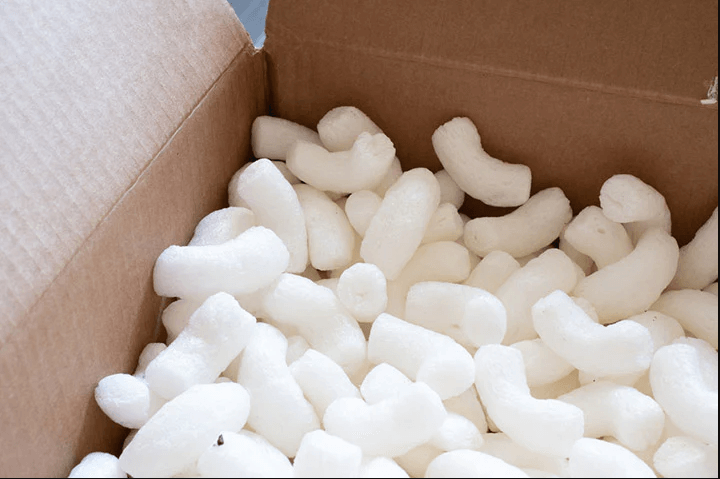
2. Corn Starch Packaging: Corn starch can be used in place of plastics since it has the same characteristics. It can be transparent or opaque and is a direct replacement for polystyrene (Styrofoam). It is ideal for things with limited use, including takeaway food packaging, cutlery, bowls, straws, glasses, water bottles, bags, plates, food storage, and so on. It is made of polylactic acid (PLA), a plastic alternative derived from fermented plant starch.
When properly disposed of, the material will degrade into carbon dioxide and water within a few months. Corn starch has disadvantages even though it is a more environmentally friendly packaging option than petroleum-based materials because it is made from maize grains. Corn starch packaging has numerous applications, including molded shapes, bottles, and loose-fill packaging. PLA, created by fermenting plant sugar and starch, is used as a base for this packaging method. One of the major advantages of corn packaging is that it may decompose into mere carbon dioxide and water within a few months, assisting in reducing both consumer and commercial carbon footprints.
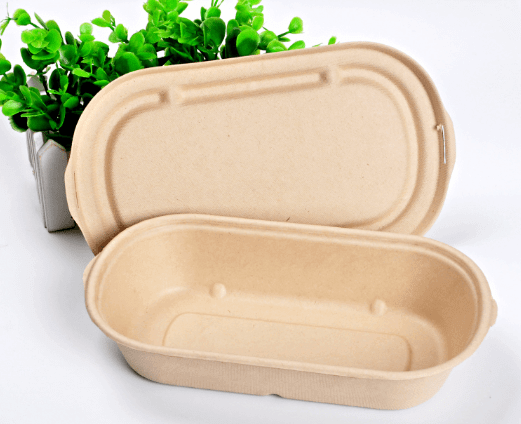
3. Mushroom Packaging: Mushrooms are utilized to provide another eco-friendly packaging option that may be used to support smaller objects. To do this, agricultural waste is utilized, cleaned, pulverized, and then joined together using mushroom roots or mycelium matrix. Neither people nor animals could eat that agricultural trash. Consequently, it avoids any dispute concerning corn-starch packaging. At-home composting of mushroom packing results in organic matter that is nontoxic. Ecovative is one such company that develops eco-friendly packaging using mushrooms.

4. Seaweed Packaging: Agar, a gelatinous material in many seaweeds and algae, is already employed in several applications. In the food industry, it can be used as a thickening or a vegetarian substitute for gelatin. The use of this as a packaging material, however, has now been prototyped by a team of designers and received a design award. Seaweed packaging can be the newest and greatest in environmentally friendly packaging solutions because it is manufactured from excellent and dependable raw materials. The major advantage of seaweed packaging materials is that they can be edible without adulterants or preservatives. Notpla, EVO & Co, & Sway are a few companies developing seaweed eco-friendly packaging.
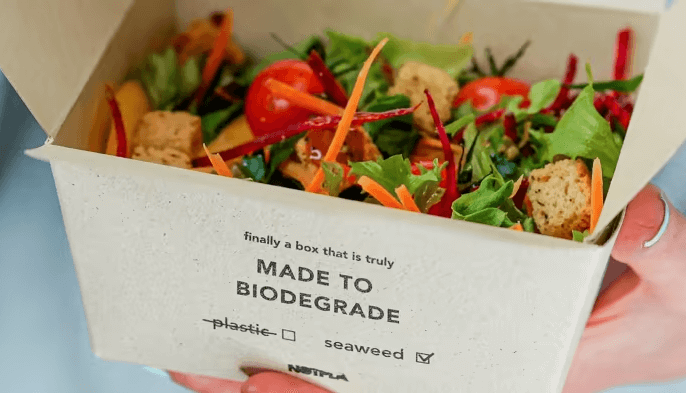
Current scenario of Sustainable Packaging
Companies require skilled designers and marketers to put efficient ideas into action, especially in the case of the sustainable packaging industry. Without compromising on quality or appearance, designers can help in selecting the packaging that is most appropriate for the product. Marketers may assist companies in setting up the groundwork for increased consumer attraction while also providing a business budgeting process.
The scenario of sustainable packaging around the world is being shaped by countries conscious of global plastic waste. For example, France wants to recycle all its plastics by 2025, and phase out single-use plastics completely by 2040. Similarly, to combat pollution, China implemented a “plastics limitation” policy in 2007. This policy was upgraded to a complete plastics ban in 2021. Since October 2020, New York has been subject to a state-wide ban on single-use plastic bags. No covered food service providers or retailers are permitted to market, sell, or distribute disposable food service containers containing expanded polystyrene foam in New York since January 2022. India too is taking action to support biodegradable substitutes, and its recent ban on single-use plastic is a testament to that. Meanwhile, Italy became the first EU nation to require manufacturers to inform consumers about the material makeup and end-of-life of their packaging. Under the 2025 National Packaging Targets, Australia wants to phase out single-use plastics and meet challenging recycling targets.
Not all sustainable packaging can support the long-term preservation of the quality and consistency of the products inside. Businesses must contact specialists and choose packaging that will offer the best durability at a reasonable cost. Instead of opting for the most sustainable packaging solution, companies must know about their products’ shelf lifespan and select the most suitable materials.
Consumer Market
The market’s growth has been fuelled by a rise in consumer awareness of green packaging techniques that employ bioplastics as a raw material in various industries, including FMCG, personal body care, and pharmaceuticals. The amount of solid trash created does not match the capability for recycling, limiting the market growth. The expansion of green products is increasing due to consumer demand and corporate public relations initiatives. Packaging will likely play a crucial role in shifting to more sustainable products, which brand owners foresee as one of the top growth drivers over the next two years.
According to Allied Market Research, the global green packaging market is anticipated to increase from $164,176.6 million in 2020 to $337,542.0 million in 2031, with a CAGR of 6.6 percent. Moreover, the returnable global packaging market is expected to grow at a CAGR of 6.5 percent between 2021 and 2030. Despite the dire circumstances, there were some beneficial outcomes throughout the pandemic. Vaccine development and approval in a few countries have brought some relief. Following the Covid-19 pandemic, the global green packaging market is predicted to rebound in a V-shaped pattern. The revenue of the major market participants, on the other hand, has been trending upward in the fourth quarter of 2020-2021.
Among promising packaging materials, seaweeds are being considered to hold high potential. The global seaweed-based packaging market is forecasted to reach USD 613 million by 2029. Seaweed being edible is a strong reason for applicability across the food & beverage industry. The material further offers high shelf life and reduces dependency on logistical support. However, there appears to be innovation required to combat the challenges related to low tensile strength and secondary supportive packaging required. Scaling the applications beyond food and beverage packaging is also to be addressed.
Impact of COVID-19 on the Sustainable Packaging Sector
Much like most other industries, the sustainable packaging sector has also seen a decline during the pandemic. The backbone of technology providers, small and medium-sized businesses, has seen a sharp decline in income since the pandemic’s emergence in 2020. As a result of supply chain interruptions, market participants faced several difficulties. However, the situation is expected to improve when more supplies arrive online in the second half of 2022.
IP Analysis and Trends in Sustainable Packaging
The innovation in the space of sustainable packaging has seen significant growth in recent years. Increasing consumer awareness and growing impact on the ecosystem and economies are major contributors in this regard. The patent trends, particularly in the last ten years have been analyzed by Sagacious IP and presented through the graphs below:
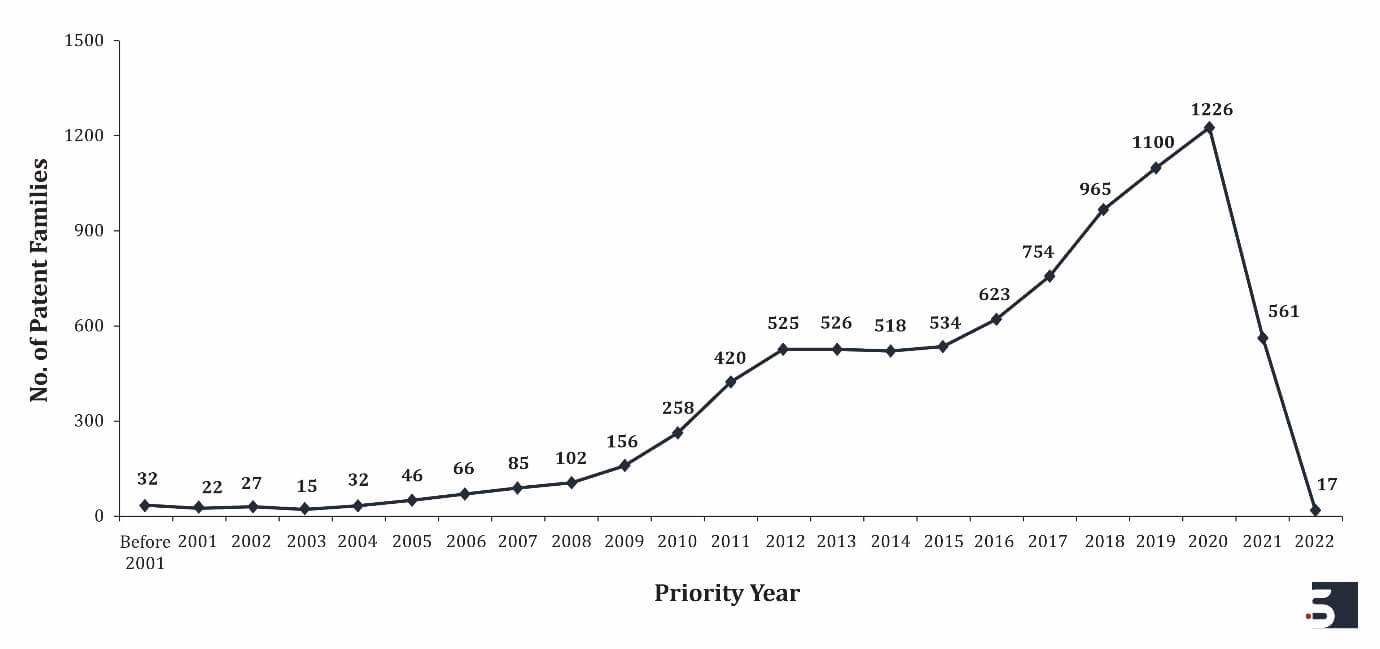
Note:
- Priority Year refers to the time when the earliest patent application was filed for an invention.
- The data pertaining to years 2020, 2021 and 2022 might not be complete, since it takes 18 months in general for a patent application to be published in the public domain.
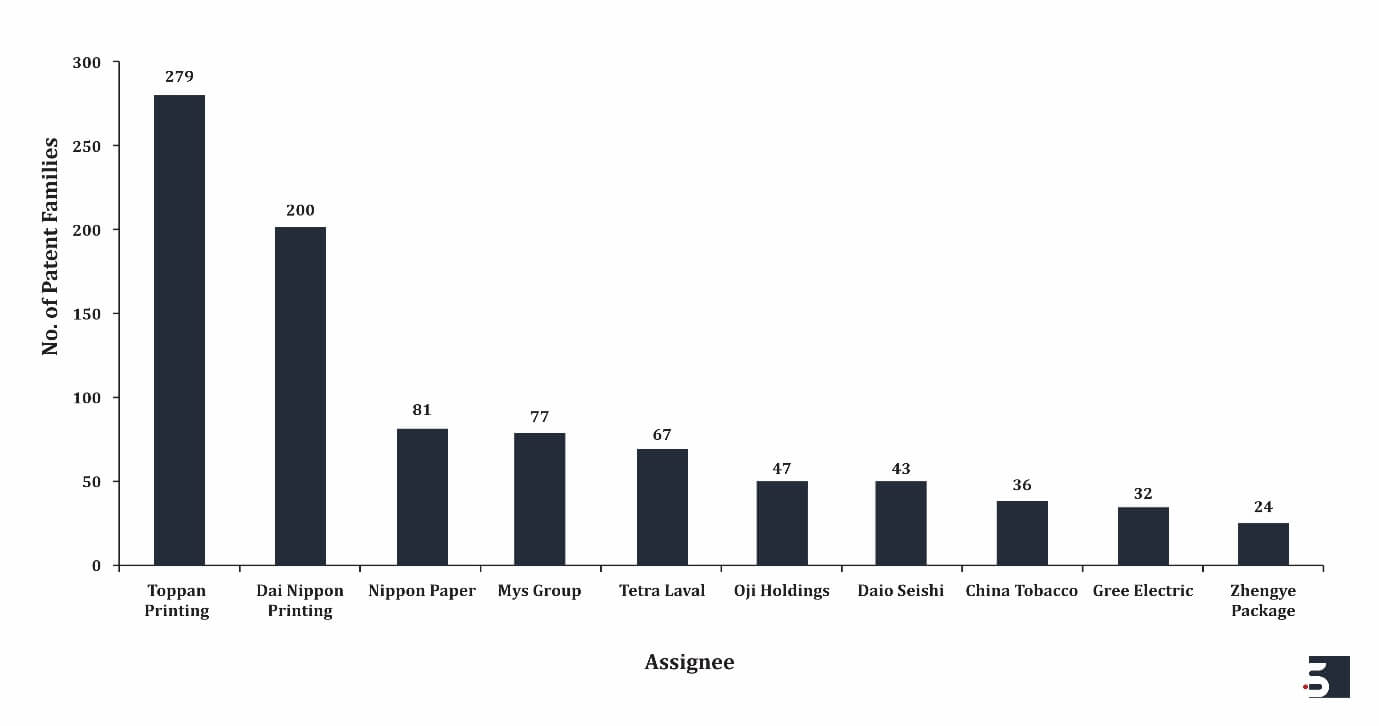
Leading countries where the research took place
China (maximum filings by several applicants – Mys Group, China Tobacco, Gree Electric, Zhengye Package) was the leading country where the research was conducted, followed by Japan (filings by some major brands such as Toppan Printings, Dai Nippon Printing, Nippon Paper). Clearly, most companies innovating in the space are based in Asia.
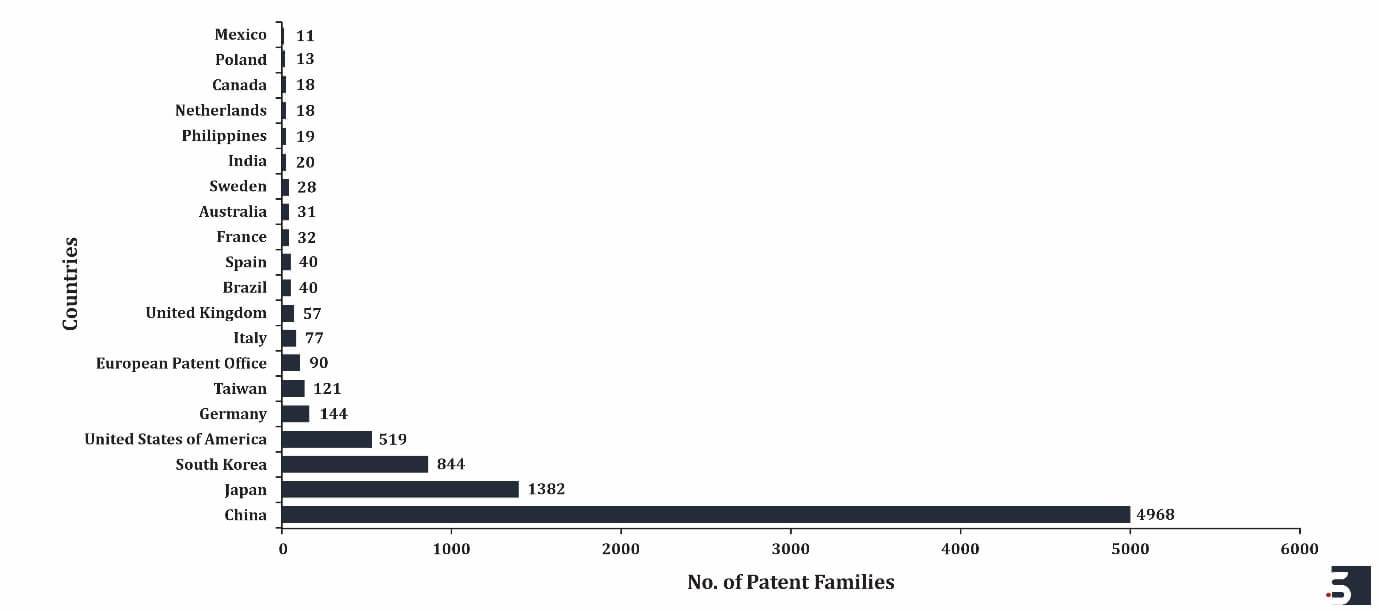
Top Technology Focus
The leading patents in sustainable packaging focus on technologies for wastewater treatment, mitigation of GHG emissions, paper-based solutions and those packaging with a specific form, etc. Figure 8 below represents the top tech classes indicated in the patents.
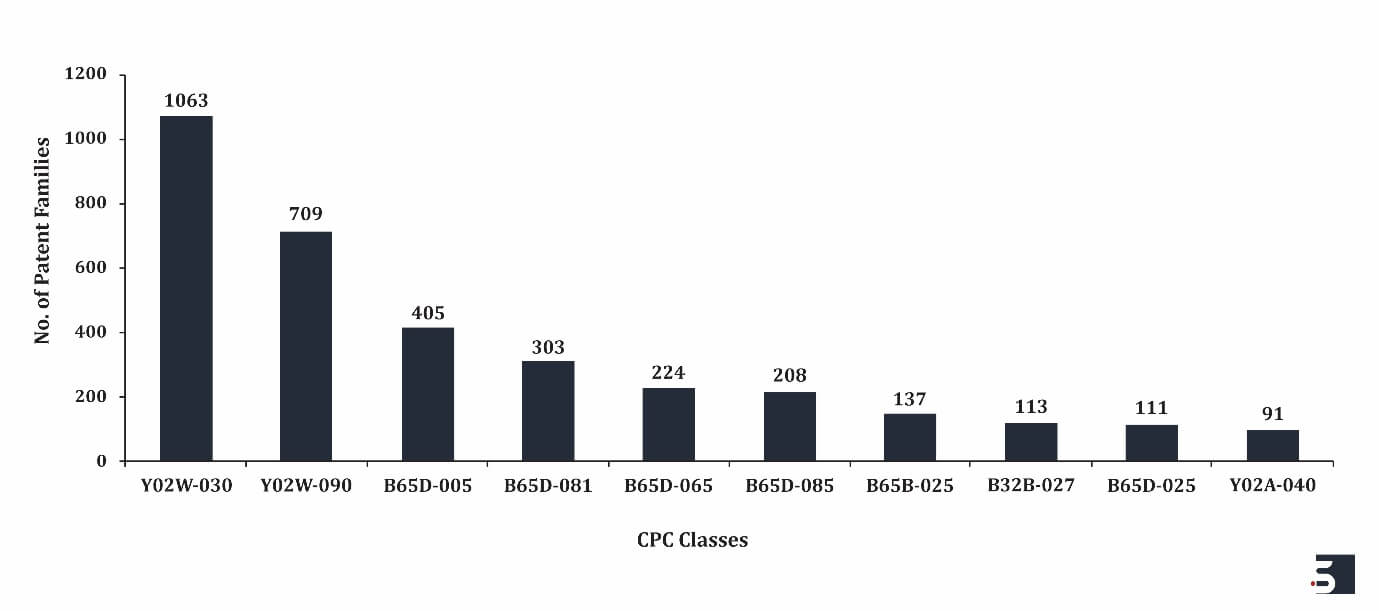
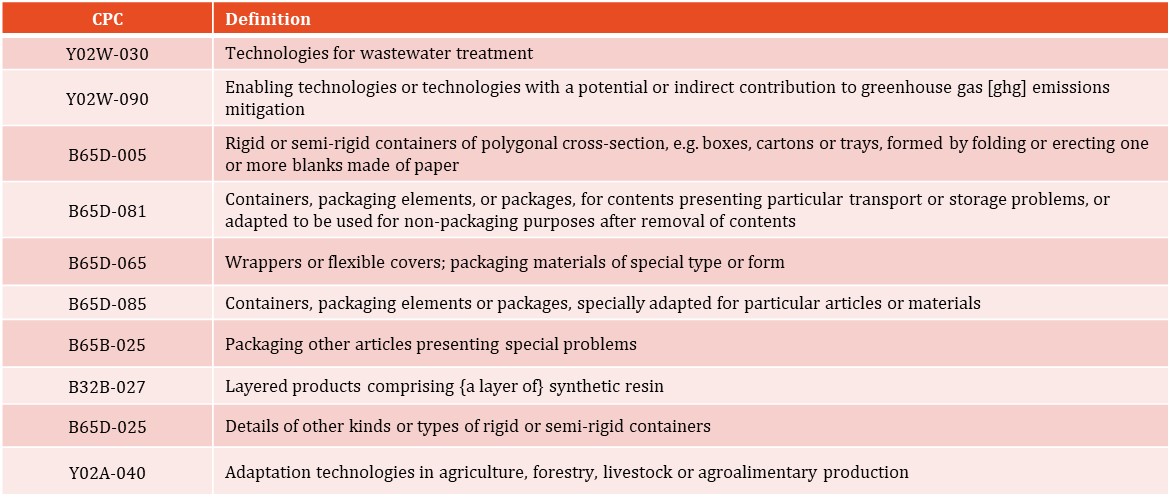
Conclusion
The usage of eco-friendly packaging has the potential for a massive positive impact. Efficient recyclable and reusable packaging can greatly reduce supply chain and logistics costs. Further, since consumers are becoming environmentally conscious, switching to eco-friendly packaging is a natural shift that companies are pursuing. The market for sustainable packaging is promising, with several drivers and some addressable challenges. Identifying the right raw material and mapping it to the sector-specific packaging requirements is a research-intensive task that is highly dependent on trial and error. Leading innovators have been working on smart solutions, and their IP protection is a strong indicator in this regard. Patented technologies in sustainable packaging have grown rapidly in recent years, especially in China, Japan, and Europe. With a continuous shift in the policies towards efficient waste management and lowering carbon footprint, the technology is expected to match industry requirements rapidly.
Conceiving and developing an idea for sustainable packaging innovation is only the beginning of a long journey. It is also critical to patent the innovation in order to protect the broader interest. Although it is possible to register the application on your own, considering the operational obstacles encountered when filing for a patent, it is recommended that you use the services of a reliable service partner.
With extensive expertise, Sagacious IP partners with clients in innovation by identifying disruptive technologies from moonshot innovations, determining innovation accelerators, developing insights to move forward with new solutions (determining solutions for upcoming challenges), and assistance in the commercialization of technology. Sagacious IP has been working with several innovative organizations researching in various areas, such as biomaterials, biochemical, polymer science, etc. to find solutions to key technical problems using our Technology Scouting service.
– Devika Saini (Life Sciences & Chemistry) and the Editorial Team
Having Queries? Contact Us Now!
"*" indicates required fields




